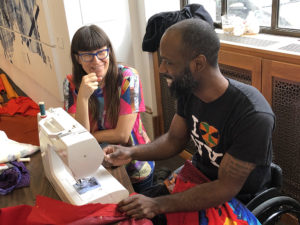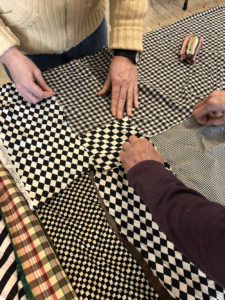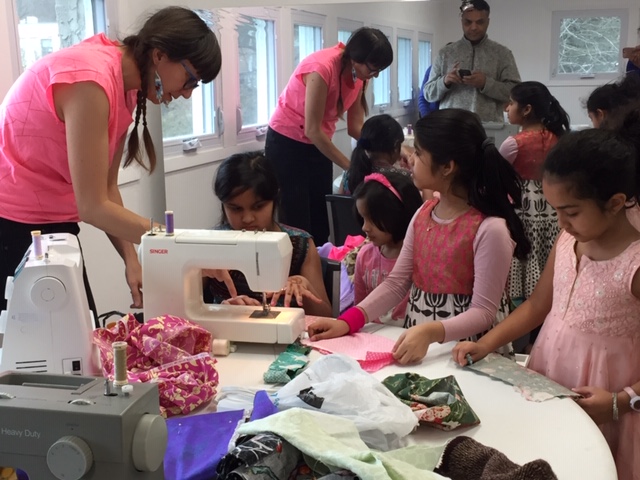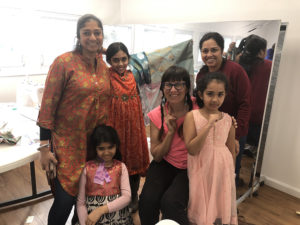What Does It Take To Make A Work Of Art? Many Hands!!!
 ArtsWestchester has embarked on a creative journey to stitch together yards and yards of donated fabric into a monumental work of public art. Sewers and stitchers from all around the county are remembering their Home Economics classes and volunteering their time at some 30-odd Public Sewing Sessions. Others with broader skills in tailoring, designing and alterations, have joined the team as well. Old draperies, swatches from Ethan Allen upholstery, bits of fabric from colorful saris and forgotten bedspreads are all getting a new life. So I asked myself: “Is this women’s work?” It is true that women are prime consumers of fabric, and the idea of reusing fabric, rewearing clothes instead of buying new ones, and making something old into something new may speak specifically to women. Then again, curtailing textile waste is a much broader concept that is more community-significant. Just like the scrap food movement, there is a conservation effort taking place in the fashion realm, led in part by the realization among fashionistas that much of the fabric produced today comes from foreign countries and winds up in dump sites around the world. In part, our goal is to demonstrate that turning old garbs into a new and beautiful work of art can lead to greater awareness of the workers who stitch and sew for little money, only to have mountains of their fabrics end up in landfills in their communities. So there is beauty to be had from curbing our addiction to fashion.
ArtsWestchester has embarked on a creative journey to stitch together yards and yards of donated fabric into a monumental work of public art. Sewers and stitchers from all around the county are remembering their Home Economics classes and volunteering their time at some 30-odd Public Sewing Sessions. Others with broader skills in tailoring, designing and alterations, have joined the team as well. Old draperies, swatches from Ethan Allen upholstery, bits of fabric from colorful saris and forgotten bedspreads are all getting a new life. So I asked myself: “Is this women’s work?” It is true that women are prime consumers of fabric, and the idea of reusing fabric, rewearing clothes instead of buying new ones, and making something old into something new may speak specifically to women. Then again, curtailing textile waste is a much broader concept that is more community-significant. Just like the scrap food movement, there is a conservation effort taking place in the fashion realm, led in part by the realization among fashionistas that much of the fabric produced today comes from foreign countries and winds up in dump sites around the world. In part, our goal is to demonstrate that turning old garbs into a new and beautiful work of art can lead to greater awareness of the workers who stitch and sew for little money, only to have mountains of their fabrics end up in landfills in their communities. So there is beauty to be had from curbing our addiction to fashion.
 On the other hand, the outpouring of people who sew, and those who want to learn, seems to be filling a need for folks to come together on simple terms… in non-judgmental terms… in non-confrontational terms. Just come out and sew. No experience needed. Just something we can do together. There is of course power in collective action. We learned that in the sandbox.
On the other hand, the outpouring of people who sew, and those who want to learn, seems to be filling a need for folks to come together on simple terms… in non-judgmental terms… in non-confrontational terms. Just come out and sew. No experience needed. Just something we can do together. There is of course power in collective action. We learned that in the sandbox.
Many times, the Public Sewing Day allows people to discuss their backgrounds without judgement and this includes religion, culture, politics… People who volunteer tend to listen more and see the space as a location to get to know people who are not always like them. They bond over the task of sewing and pinning and it opens people up to feeling comfortable and discussing their past.
In fact, the act of sewing seems to take some back to their roots. At a sewing session at The Arc Westchester, one participant reflected: “That is the power of doing things with your hands…it brings you back to where you came from and the people who taught you to be who you are today.” Pretty exciting stuff for what started as a simple sewing circle.




Connect with Janet